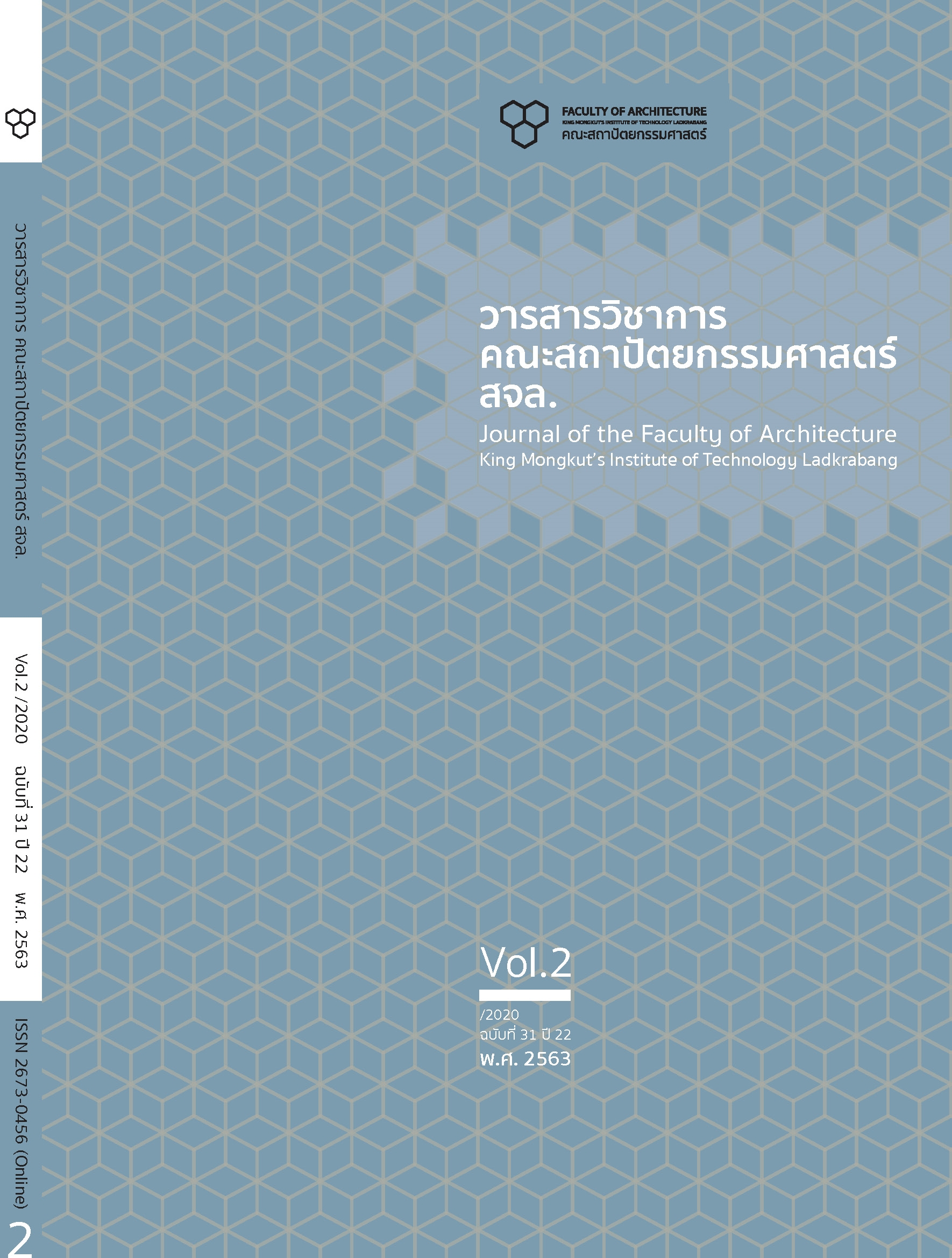The Composition of Mural Painting that Emphasize the Axis to the Principal Buddha’s Image in the Ordination Hall of the Late Ayutthaya Period
Main Article Content
Abstract
The aim of this research is to analyze compositions of mural paintings that emphasize a viewpoint to the principal Buddha’s image in the ordination hall (Ubosot) to confirm the concept of symmetrical layout approaching to the Buddha’s image in Ubosot. In general, Ubosot is located at Buddha’s shrine and it also has a meaning of a place of the Lord Buddha. However, there is a lack of empirical data to support this interior environment concept. Therefore, the main research question is how to arrange the compositions of mural painting that emphasize the approach to the principal Buddha’s image. To answer, this research chose three important case studies in Wat No Phutthangkun, Wat Pratu San at Suphanburi province and Wat Koh Kaew Suttharam at Phetchaburi province. All of them, similar in area sizes and dimensions, are Ubosot in the late Ayutthaya period. In addition, their interiors have murals paintings that are drawn across all four sides of the walls and the condition in every side is still in good condition. This research is a survey study based on building surveys and photographing mural paintings. As a consequence, the compositions of the mural paintings affecting the vista of the Buddha’s image were compared and analyzed by referring to the mural painting elements from the literature review.
The findings of this research indicate that compositions of mural paintings could create the approach to the principal Buddha’s image through two important methods which are 1) to divide the mural painting with Thai patterned lines making the vanishing point direct to the principal Buddha’s image by Thai front line, Sintao lines (or zigzag lines), and Horh lines (or curved lines) and 2) to decorate the mural painting plane with the triangle shape emphasizing the principal Buddha’s image. In brief, with these two methods, it could confirm the concept of using symmetrical balance emphasizing the perspective towards the Buddha’s image in a three-dimensional manner of interior environment decoration. This data could be used to explain and teach students in the next field studies.
Article Details
This work is licensed under a Creative Commons Attribution-NonCommercial-ShareAlike 4.0 International License.
Copyright Transfer Statement
The copyright of this article is transferred to Journal of The Faculty of Architecture King Mongkut's Institute of Technology Ladkrabang with effect if and when the article is accepted for publication. The copyright transfer covers the exclusive right to reproduce and distribute the article, including reprints, translations, photographic reproductions, electronic form (offline, online) or any other reproductions of similar nature.
The author warrants that this contribution is original and that he/she has full power to make this grant. The author signs for and accepts responsibility for releasing this material on behalf of any and all co-authors.
References
กฤษณ์ ทองเลิศ. (2554). แนวทางการศึกษาการสื่อความหมายของงานภาพจิตรกรรมฝาผนังไทย. วารสารนิเทศสยาม- ปริทัศน์. 10(2), 5-26.
เจนยุทธ ล่อใจ. (2550). แนวแกนที่ไม่สามารถมองเห็นได้ในงานสถาปัตยกรรม. (วิทยานิพนธ์สถาปัตยกรรมศาสตร- มหาบัณฑิต สาขาวิชาสถาปัตยกรรม บัณฑิตวิทยาลัย มหาวิทยาลัยศิลปากร).
ภาณุพงษ์ เลาหสม และ ชัยยศ อิษฏ์วรพันธุ์. (2549). เปลี่ยนพื้น แปลงภาพ ปรับรูป ปรุงลาย: การวิเคราะห์วิธีการ ออกแบบและวาดจิตรกรรมฝาผนังยุคต้นรัตนโกสินทร์. กรุงเทพฯ: เมืองโบราณ.
ภิญโญ สุวรรณคีรี. (2546). ลวดลายองค์ประกอบสถาปัตยกรรมไทย. กรุงเทพฯ: โรงพิมพ์ดอกเบี้ย.
วีระยุต ขุ้ยศร. (2557). ปัจจัยที่ทำให้เกิดความคิดสร้างสรรค์ในวิชาวิเคราะห์การออกแบบ สาขาวิชาสถาปัตยกรรมและการ วางแผน คณะสถาปัตยกรรมศาสตร์ สถาบันเทคโนโลยีพระจอมเกล้าเจ้าคุณทหารลาดกระบัง. วารสารวิชาการ คณะสถาปัตยกรรมศาสตร์ สจล. 18(1), 65-78.
วีระยุต ขุ้ยศร. (2560). การศึกษาตำแหน่งช่องเปิดที่ส่งผลด้านแสงสว่างต่อพระประธานภายในพระอุโบสถ. วารสารวิชาการ คณะสถาปัตยกรรมศาสตร์ สจล. 24(1), 36-49.
สน สีมาตรัง. (2522). จิตรกรรมฝาผนังสกุลชางรัตนโกสินทร. กรุงเทพฯ: อมรินทรการพิมพ์.
สน สีมาตรัง. (2559). คติความเชื่อไตรภูมิและจักรวาลวิทยาในจิตรกรรมฝาผนังไทย. พิมพ์ครั้งที่ 2. กรุงเทพฯ: คณะมณฑนศิลป์ มหาวิทยาลัยศิลปากร.
สมคิด จิระทัศนกุล. (2547). รูปแบบพระอุโบสถและพระวิหารในสมัยพระบาทสมเด็จพระจอมเกล้าเจ้าอยู่หัว. กรุงเทพฯ: เมืองโบราณ.
สันติ เล็กสุขุม. (2548). จิตรกรรมไทยสมัยราชกาลที่ 3 ความคิดเปลี่ยน การแสดงออกก็เปลี่ยนตาม. กรุงเทพฯ: เมืองโบราณ.
สันติ เล็กสุขุม. (2553). งานช่างคำช่างโบราณ. กรุงเทพฯ: รุ่งศิลป์การพิมพ์.
อนุโรจน์ จันทร์โพธิ์ศรี, พิษณุศุภนิมิตร และ ปรีชา เถาทอง. (2559). การแปรเปลี่ยนจากรูปธรรมของจิตรกรรมของไทยสู่หลักธรรมในพุทธศาสนา. วารสาร Veridian E Journal, Silpakorn University. 9(2), 2361-2375.
Horn, D., & Salvendy, G. (2009). Measuring Consumer Perceptions of Product Creativity: Impact on Satisfaction and Purchasability. Human Factors and Ergonomics in Manufacturing. 19(1), 223–240.


